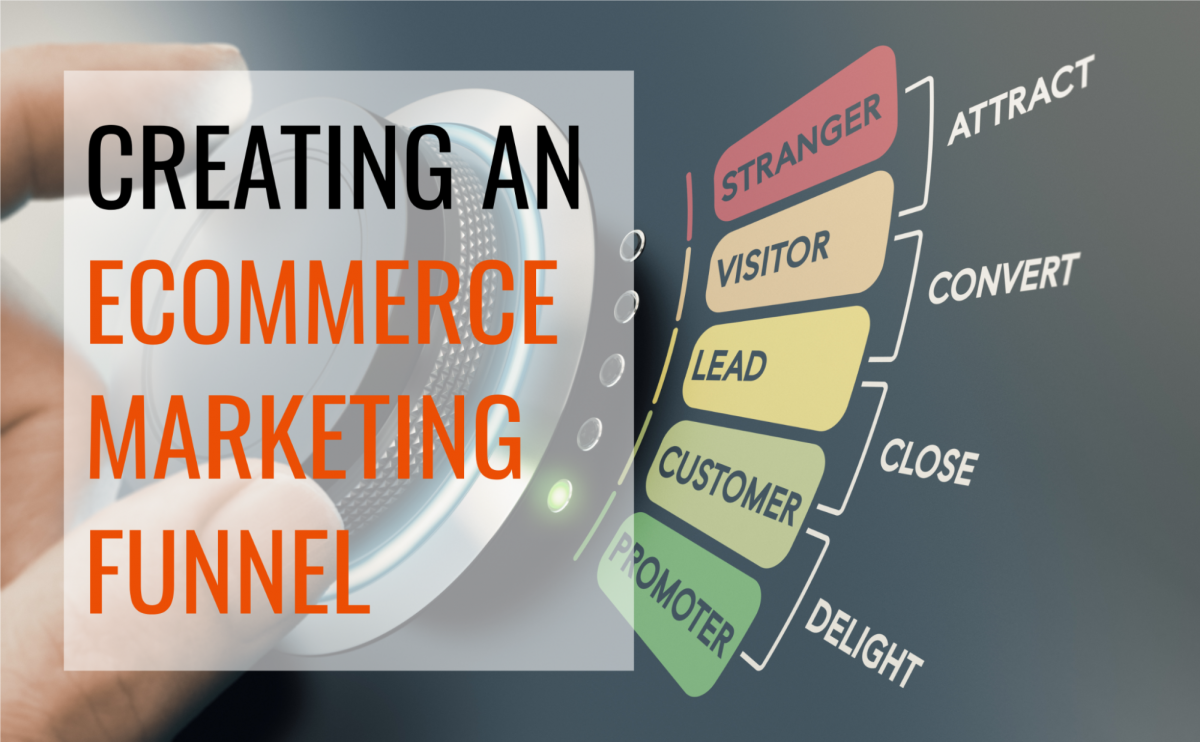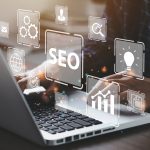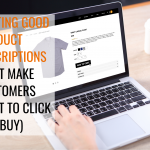In an ideal world, a customer would arrive on your landing page, add a product to their cart, and then head to the checkout. However, the reality is that in the competitive world of ecommerce, things don’t usually work out that way. With an estimated 12 to 24 million ecommerce sites across the internet, converting leads into sales takes a lot of work and should never be left to chance.
One method that many ecommerce stores use to drive relevant traffic and improve conversation rates are ecommerce marketing funnels. If you’re not using marketing funnels, then you’ll want to think about getting started! In this article, we’ll take a look at some of the ways that an ecommerce marketing funnel can help your business grow.
What Is an Ecommerce Marketing Funnel?
In a nutshell, an ecommerce marketing funnel is a technique to visually illustrate your buyer’s journey. It’s made up of the steps a customer makes from first becoming aware of your brand to then moving down the funnel to make a purchase, and finally, becoming a repeat buyer.
According to Yieldify, “some consumers slide through the funnel quickly, going from a lead to a fan in the blink of an eye. Other consumers navigate sales funnels like three-toed sloths, taking months or years to reach your checkout.”
This is because every business has a unique sales funnel, depending on the type of industry they’re in, the demographic markets they target, and the products they sell, which all influence the pace and complexity of their funnel.
For example, an online store that sells low-cost products can often convert customers faster, as elements such as price are less of an obstacle which allows them to reach the purchasing stage much quicker. At the opposite end of the spectrum, a business in the luxury market will often have a much longer sales funnel, as it’s harder to get customers over the line.
Does Your Business Need an Ecommerce Marketing Funnel?
The short answer is yes. If you want your online store to succeed and maximize its full potential, incorporating an ecommerce conversion funnel into your marketing strategy is a must.
As Yieldify puts it, “Winners keep score, and successful businesses invariably think about where their customers come from.” This is exactly what a sales funnel does: it ensures that you’re gathering all the right information on your consumers, and then using it effectively to drive sales and create a loyal customer base.
While in some cases there are benefits to driving traffic straight to a product page, it’s often it is better to send potential customers to a long or short-form sales page.
- Long form sales page – This is a landing page that relies heavily upon extensive written content, such as a blog post educating prospects about your product and how it can solve their problems.
- Short-form sales page – A landing page with less written content, more visuals, or testimonials.
Which one’s best? That depends on your goals, the product that you’re selling, and the stage in the purchasing journey your buyer is in. With some products, your audience will need more education first in order to convert. This is especially true for higher-value items. For products that are less than $20, or anything that’s an impulse buy, you won’t need much of a funnel.
It also depends where your traffic’s coming from. Traffic coming from Facebook ads, for example, will usually require more education whereas long-term keywords often indicate intent, and so you’ll probably be able to get away with less education.
Now that we’ve seen the importance of a conversion funnel, let’s take a look at how they work.
The 5 Stages of an Ecommerce Marketing Funnel
Usually, an ecommerce conversion funnel involves four to five stages. The best way to convert leads and generate sales is to ensure that you’re optimizing each stage of the conversion funnel. Let’s take a look at each of these stages.
(Source)
Stage 1: Awareness
This stage is when a customer first becomes aware of your brand, products, or services. Usually, this is the result of your marketing efforts, where someone’s seen your social media posts, received your emails, or discovered your product through word of mouth.
To move consumers along to the next stage of your sales funnel, website optimization platform Crazy Egg recommends focusing on creating educational content about your brand. “Show that you’re generous in giving up free information like blog posts, webinars, reports, and guides,” they state.
Stage 2: Interest
This next stage is when you try to hook this potential customer’s attention and begin fostering a relationship. Essentially, you’re wanting to spark their interest in your brand and products, while at the same time gathering data about their interests and needs. To achieve this and have consumers slide along to the next phase in your sales funnel, consider using tactics such as retargeted social media ads, email marketing, or surveys.
Stage 3: Desire
Now that you have your customer’s interest, it’s time to start building desire. Using the information gathered on your customer in the previous stage, begin to talk about your product’s benefits and how it can provide a solution to their needs.
Apple is an example of a brand that does the desire stage brilliantly. The company hardly talks about its specific and uninteresting features, such as internal digital chips. Instead, it focuses on constantly telling its audience about how its products are easy for anyone to use, elegant, safe, and ultimately desirable.
The trick to this stage is to diligently focus on your messaging, putting extra emphasis on how the consumer will benefit, especially from your product, which is how you’ll get them along to the next stage.
Stage 4: Action
Now has come the time to close the sale, with the goal being that your potential customer adds your products to their shopping carts, heads to checkout, and completes the payment process.
One way to achieve this is to entice customers with discounts or free trial periods, which all encourage them to complete the transaction. To speed the process up even more, and begin the next stage of customer retention, think about putting a time limit on the discounts or trials you’ve offered.
Stage 5: Retention
A common mistake that many ecommerce businesses make is thinking the conversion funnel ends after a customer makes their first purchase. Repeat buyers and customers are invaluable to any business, for it’s far cheaper and easier to retain existing customers than attract new ones.
Loyalty programs are one way that many online ecommerce businesses are approaching customer retention. However, depending on the size of your ecommerce business, you may also use customer relationship management (CRM) software to maintain rapport.
Implementing Your Ecommerce Marketing Funnel
Now that you know what a sales funnel entails and its different elements, the next step is to start carrying out each stage using various marketing strategies and techniques. Whether it’s your first time creating an ecommerce marketing funnel, or you’re wanting to improve an existing one, here are six popular and result-driven tactics to consider using in your conversion funnel.
Social Media Ads
With more than 4.62 billion active social media users worldwide, many of the top social platforms offer businesses many ways to reach consumers. For example, Facebook ads allow you to target specific audiences based on their demographics and interests, giving you plenty of control when it comes to reaching customers in your market.
Social media ads can also be used throughout various stages of the conversion funnel, such as the awareness stage with educational ads to inform consumers, or during the desire phase to build their interest in your products.
Get our Creating an Ecommerce Marketing Funnel - Worksheet delivered right to your inbox.
Content Marketing
Engaging content demonstrates to your consumers who your brand is and what it stands for. It’s important to remember that simply knowing your brand’s name isn’t enough; they should also be aware of the characteristics that distinguish your brand and the vision you stand for.
This is where content marketing can come in. The trick is to create content that will distinguish your brand from competitors. The best way to do this is to share specific and unique information about your products and brand to entice potential customers to choose you over your competitors.
(Source)
Shopify is a great example of a brand that uses content marketing to aid its conversion funnel. To attract customers and build desire, Shopify regularly shares educational content and insights about entrepreneurship and ecommerce across almost all its social channels. This hooks in their target audience immediately and taps into their needs while building a desire to then use Shopify’s services for their own business.
Emailing
Right from the beginning of your sales funnel, it’s a good idea to begin gathering consumers’ email addresses for future email marketing. This can be achieved by offering trial subscriptions, news customer discount codes, or free educational content, that all require a potential customer to pass over their email information.
Once you’ve started to build your email database, you can then get to work at creating effective email campaigns to persuade this consumer to shop with you. One company that uses the technique well to engage its customers is Uber. The popular transportation app uses email as a way to keep its clients updated on changes, to offer discounts and promotions, and guides, all in a simple and sleek manner that keeps customers happy and engaged.
Optimize Your Product Pages
The work doesn’t stop once a consumer has entered your site and begins browsing your product pages. The customer still must buy the product, which they are only going to do if they’ve been fully convinced. Optimizing your product pages and nudging consumers in the right direction to add products to their carts is one way to get a customer over the line.
To achieve this, ensure your pages nail elements such as having engaging product descriptions, quality photos and/or videos of your products, product testimonials, fast loading times, and even product comparisons.
Personalize Your Engagement
One of the best ways to engage consumers is through personalization. In fact, modern consumers now expect it. Once you’ve begun to gather information on potential customers’ needs and wants, it’s time to start personalizing your engagement with them. This can be done in a multitude of ways, from targeted adverts, personalized emails, using AI tools, and even SMS marketing.
Amazon is a great example of a company that masters personalization. Once a customer has been browsing the site for a while and Amazon has gathered enough information on their interests, it then begins to offer personalized recommendations to the shopper through pop-ups and product recommendations. All of this further entices a shopper to make purchases by responding to their direct needs and desires.
Use Ecommerce Sales Funnel Software
Ecommerce marketing funnels are never easy to build, taking plenty of resources and time to get right. Using ecommerce funnel software is a wonderful alternative if you want to condense your approach under one roof, whether you’re a total newbie or have an existing sales funnel but want to improve it.
(Source)
Many funnels software help with building conversion-oriented landing pages, creating membership sites, developing personalized and behavior-based emails, payment processing tools, and much more. Some of the more popular ecommerce sales funnel software to consider include Groove, Constant Contact, and ClickFunnels.
What Happens Once They’re in the Funnel?
Okay, so what happens when you have someone in your funnel? That’s where the real work begins!
Once you get someone in your funnel, having the right retargeting campaigns, email sequences, and content drips will exponentially increase conversion rates. Take a look at how these break down quickly below:
- Retargeting Campaigns – Retargeting allows you to target interested prospects with ads for your product even after they leave your site. This is an immensely valuable form of advertising.
- Email Sequences – Owning your own first-party data, including email addresses, is vitally important. Make sure you’re collecting email addresses now through some sort of lead magnet for sign-ups so that you can start sending out email sequences to guide your visitors down through the funnel.
- Content Drips – Dripping content is a way to release content to your users. They receive content a bit by bit slowly over the course of a few weeks or months until they have access to your entire library.
Ecommerce Marketing Funnels FAQs
What are the main stages of an ecommerce marketing funnel?
The five main stages of a marketing funnel are awareness, interest, desire, action, and retention. However, each brand’s funnel will be unique to its own business based on the products or services they sell.
How do you create a marketing funnel for ecommerce?
Alongside the five stages of an ecommerce marketing model, incorporate various marketing techniques to fuel each step of the funnel, and have consumers complete your customer journey.
How can you improve an existing funnel?
To improve your existing funnel, it’s probably a good idea to first look at your overall marketing plan and assess its effectiveness in generating leads and sales.
Following the review of your marketing strategy, consider updating your tactics to better suit your customer base and represent your customer journey, such as including more personalized content, or beginning social media ads.
The Next Step: Building Your Optimized Ecommerce Marketing Funnel
Now that you’ve got all the information you need to build an ecommerce marketing funnel, it’s time to get to work. Here’s how you can get started.
Step One: Define Your Customer Journey
Using a tool such as Google Analytics, figure out what consumers are doing when they arrive on your site. Ask questions such as does a visitor’s behavior change between first arriving on your landing page or a product page? What referring domains are driving the most traffic? How many touchpoints are your consumers making before purchasing?
Step Two: Design your Funnel Stages
Keeping in mind the five stages of a basic marketing funnel identified in this article, create your own plan on how your consumers will slide through your tunnel. This is when you can start considering what marketing tactics should be implemented at certain stages, such as using personalized emails during the desire phase.
Step Three: Customer Retention
Once customers are starting to make their way through your sales funnel and purchase your products, don’t forget to retain them. This is where a loyalty program could come into play or follow-up emails to maintain their interest in your brand to further develop the relationship.
Learn more about content funnel mapping.
Reach out today for your free 20-minute consultation. Let’s find strategies that you can implement today, things that’ll help your business to grow.
Get our Creating an Ecommerce Marketing Funnel - Worksheet delivered right to your inbox.







